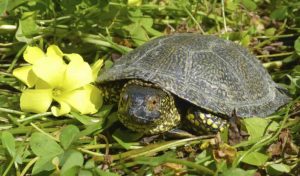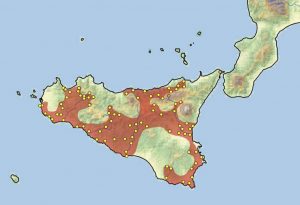Emys trinacris, 112
Emys trinacris Fritz, Fattizzo, Guicking, Tripepi, Pennisi, Lenk, Joger, and Wink 2005 –
Sicilian Pond Turtle, Testuggine Palustre Siciliana
Dario Ottonello1, Stefania D’Angelo2, Federico Marrone3, Fabrizio Oneto1,4,
Filippo Spadola5, Marco Alberto Luca Zuffi6, and Uwe Fritz7
1Centro Studi Bionaturalistici srl, Corso Europa 26, 16132 Genova, Italy [[email protected]];
2WWF Italia, via Po 25/c, 00195 Roma, Italy [[email protected]];
3Dipartimento di Scienze e Tecnologie Biologiche, Chimiche e Farmaceutiche (STEBICEF),
Università di Palermo,Via Archirafi 18, 90123 Palermo, Italy [[email protected]];
4Dipartimento di Scienze della Terra dell’Ambiente e della Vita (DISTAV),
Università di Genova, Corso Europa 26, 16132 Genova, Italy [[email protected]];
5Museo della Fauna, Dipartimento di Scienze Veterinarie,
Polo Universitario SS. Annunziata 98128, Messina, Italy [[email protected]];
6Museum of Natural History, University of Pisa, via Roma 79, 56011 Calci (Pisa), Italy [[email protected]];
7Museum of Zoology (Museum für Tierkunde), Senckenberg Dresden,
A. B. Meyer Building, 01109 Dresden, Germany [[email protected]]
Summary. – The Sicilian Pond Turtle, Emys trinacris (family Emydidae), is a small-sized freshwater turtle (straight midline carapace length to 172 mm in females, 156 mm in males), endemic to the island of Sicily in Italy. It appears to be more widespread in the northern and central-western parts of the island, with the exclusion of Monti Peloritani and most of the Madonie area and Monti di Termini Imerese. It is apparently rarer along the southeastern coastal areas, except for some coastal wetlands in the provinces of Trapani, Agrigento, Siracusa, and Ragusa. The species shows an altitudinal distribution range from sea level to about 1250 m a.s.l., with a higher prevalence in coastal and hilly territories, except for the Nebrodi area, where it is quite common in mountainous areas as well. Emys trinacris inhabits coastal and inland wetlands, mountain lakes and ponds, slow-moving river bends, and man-made aquatic environments, both in open areas and in woodlands. The few studied populations appear relatively robust at present, but others appear to be decreasing, and a lack of detailed recent field data prevents sound conclusions from being drawn about its overall status. Indeed, ongoing patterns of habitat loss and alteration, combined with climate change, release of non-native species in the wild, and poaching for the pet trade threaten this species.
Distribution. – Italy (Sicily).
Synonymy. – Emys trinacris Fritz, Fattizzo, Guicking, Tripepi, Pennisi, Lenk, Joger, and Wink 2005; Emys orbicularis trinacris.
Subspecies. – None recognized.
Status. – IUCN 2020 Red List: Data Deficient (DD; assessed 2009); TFTSG Provisional Red List: Least Concern (LC, assessed 2018); CITES: Not Listed.
Citation:
Ottonello, D., D’Angelo, S., Marrone, F., Oneto, F., Spadola, F., Zuffi, M.A.L., and Fritz, U. 2021. Emys trinacris Fritz, Fattizzo, Guicking, Tripepi, Pennisi, Lenk, Joger, and Wink 2005 – Sicilian Pond Turtle, Testuggine Palustre Siciliana. In: Rhodin, A.G.J., Iverson, J.B., van Dijk, P.P., Stanford, C.B., Goode, E.V., Buhlmann, K.A., and Mittermeier, R.A. (Eds.). Conservation Biology of Freshwater Turtles and Tortoises: A Compilation Project of the IUCN/SSC Tortoise and Freshwater Turtle Specialist Group. Chelonian Research Monographs 5(15):112.1–13. doi: 10.3854/crm.5.112.trinacris.v1.2021; www.iucn-tftsg.org/cbftt/.
Download pdf
Adobe Acrobat 6.0 or later required)
Adult male Emys trinacris with reddish eyes from Laghetto Gorgo, Sicily, Italy.
Photo by Melita Vamberger.
.
Distribution:
Distribution of Emys trinacris on the island of Sicily, southwestern Italy. Yellow dots = museum and literature occurrence records of native populations based on Iverson (1992) plus more recent and authors’ data; orange dots = uncertain or introduced specimens; red shading = presumed native historic indigenous range. Distribution based on GIS-defined level 12 HUCs (hydrologic unit compartments) constructed around verified localities and then adding HUCs that connect known point localities in the same watershed or physiographic region, and similar habitats and elevations as verified HUCs (Buhlmann et al. 2009; TTWG 2017, in press), and adjusted based on authors’ subsequent data and then refigured as a smooth polygon.










